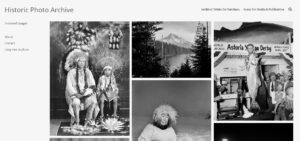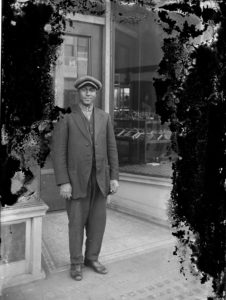
By Thomas Robinson
This posting has been corrected for errors of sequence and fact, I appreciate the comments and information.
Photo taken February 14, 1953. Archibald James Carey Jr. (1908 – 1981) speaking in Portland at Lincoln High School on Lincoln day. He was a Black American lawyer, judge, politician, diplomat and clergyman from the south side of Chicago. Carey was also King’s longtime mentor and friend.
Seven months before the Portland speech this photograph shows, Carey was a keynote speaker at the 1952 Republican National Convention, and that speech is considered to be the seed of many of the sentences that Martin Luther King used in his “I Have a Dream” speech.
On July 8, 1952, the finale of Carey’s address to the Republican convention was: “We, Negro Americans, sing with all loyal Americans: ‘My country ‘tis of thee, Sweet land of liberty, Of thee I sing. Land where my fathers died, Land of the Pilgrim’s pride! From ev’ry mountainside, Let freedom ring!’ That’s exactly what we mean–from every mountain side, let freedom ring. Not only from the Green Mountains and White Mountains of Vermont and New Hampshire; not only from the Catskills of New York; but from the Ozarks in Arkansas, from the Stone Mountain in Georgia, from the Blue Ridge Mountains of Virginia–let it ring not only for the minorities in the United States; but for … the disinherited of all the earth…–may the Republican Party, under God, from every mountainside, LET FREEDOM RING!”
For comparison, this is what Martin Luther King said in Washington DC on August 28, 1963: “This will be the day when all God’s children will sing with new meaning “My country ’tis of thee, sweet land of liberty, Of thee I sing. Land where my fathers died! Land of the Pilgrim’s pride! From ev’ry mountainside, Let freedom ring!” And if America is to be a great nation this must come true. So let freedom ring from the prodigious hilltops of New Hampshire. Let freedom ring from the mighty mountains of New York. Let freedom ring from the heightening Alleghenies of Pennsylvania! Let freedom ring from the snow capped Rockies of Colorado! Let freedom ring from the curvaceous peaks of California! Let freedom ring from Stone Mountain in Georgia! Let freedom ring from Lookout Mountain of Tennessee! Let freedom ring from every hill and molehill of Mississippi. From every mountainside, let freedom ring.
None of this was written in King’s prepared text of his speech. Halfway through it, Mahalia Jackson, a gospel singer and good friend of King’s, shouted “tell ‘em about the ‘dream.” From this point in the speech, King stopped looking down at his notes and improvised.
In the Stanford University Martin Luther King Papers Project, the editors write: “Like many 19th-century orators who often borrowed from one another, King adopted his conclusion from Chicago preacher Archibald Carey’s address at the 1952 Republican convention, who in turn adapted the patriotic song, “My Country, ‘Tis of Thee.”
In 1957, King spoke in St. Louis and said “As I heard a great orator say some time ago, freedom must ring from every mountainside.”
It is likely that Carey’s use of the mountain metaphor, which he used at the Republican National Convention seven months before his speech in Portland, and was later used by King in 1963, was heard in Portland in 1953.
It is interesting to note how the Republican party changed so dramatically in the 1964 election. Since the time of Abraham Lincoln, the Republicans had been the leaders in Civil Rights legislation for Blacks, and for American Indians as well. Locally, Senator Mark Hatfield participated in many Civil Rights activities. This all changed during Kennedy’s administration, and many Black voters left the Republican party during the Goldwater/Johnson election in 1964, which Johnson won, and resulted in the Civil Rights act’s passage the next year. Since then, the Democratic party has led Black Civil Rights legislation, and the Republicans inherited the Southern White votes.
It is likely that KOIN broadcast the Portland speech, judging by their microphone, but I’m unable to track a recording or transcript of it today.
Photograph by Allan deLay (1915-2005) and ©Thomas Robinson. Reproduction prohibited without written permission.
Sources of information:
The Oregonian, February 14, 1953, pg. 7 “Lincoln Talk Set”
Keith D. Miller, “Voice Merging and Self-Making: The Epistemology of ‘I Have a Dream,’” Rhetoric Society Quarterly 19 (Winter, 1989), 23-31. http://www.jstor.org/stable/3885221?seq=1#page_scan_tab_contents
Wikipedia entry for Carey: http://en.wikipedia.org/wiki/Archibald_Carey_Jr.
Anne Wortham, “Martin Luther King’s Flawed Dream,” The World and I, June 1998, 66-71.http://www.questia.com/library/1G1-21154755/martin-luther-king-s-flawed-dream quoted by Lew Rockwell at https://www.lewrockwell.com/2013/08/anne-wortham/was-the-mlk-dream-speech-original/#_ednref3
Clayborne Carson, Ralph E. Luker, Penny A. Russell, eds., The Papers of Martin Luther King, Jr.: Birth of a New Age : December 1955-December 1956 Vol. III, Berkeley: University of California Press, 1997. See “Carey, Archibald J., Jr. (1908-1981),” at http://mlk-kpp01.stanford.edu/index.php/encyclopedia/
Carmine Gallo “How Martin Luther King Improvised ‘I Have A Dream'” Forbes http://www.forbes.com/sites/carminegallo/2013/08/27/public-speaking-how-mlk-improvised-second-half-of-dream-speech/#7c802e44d4bf










